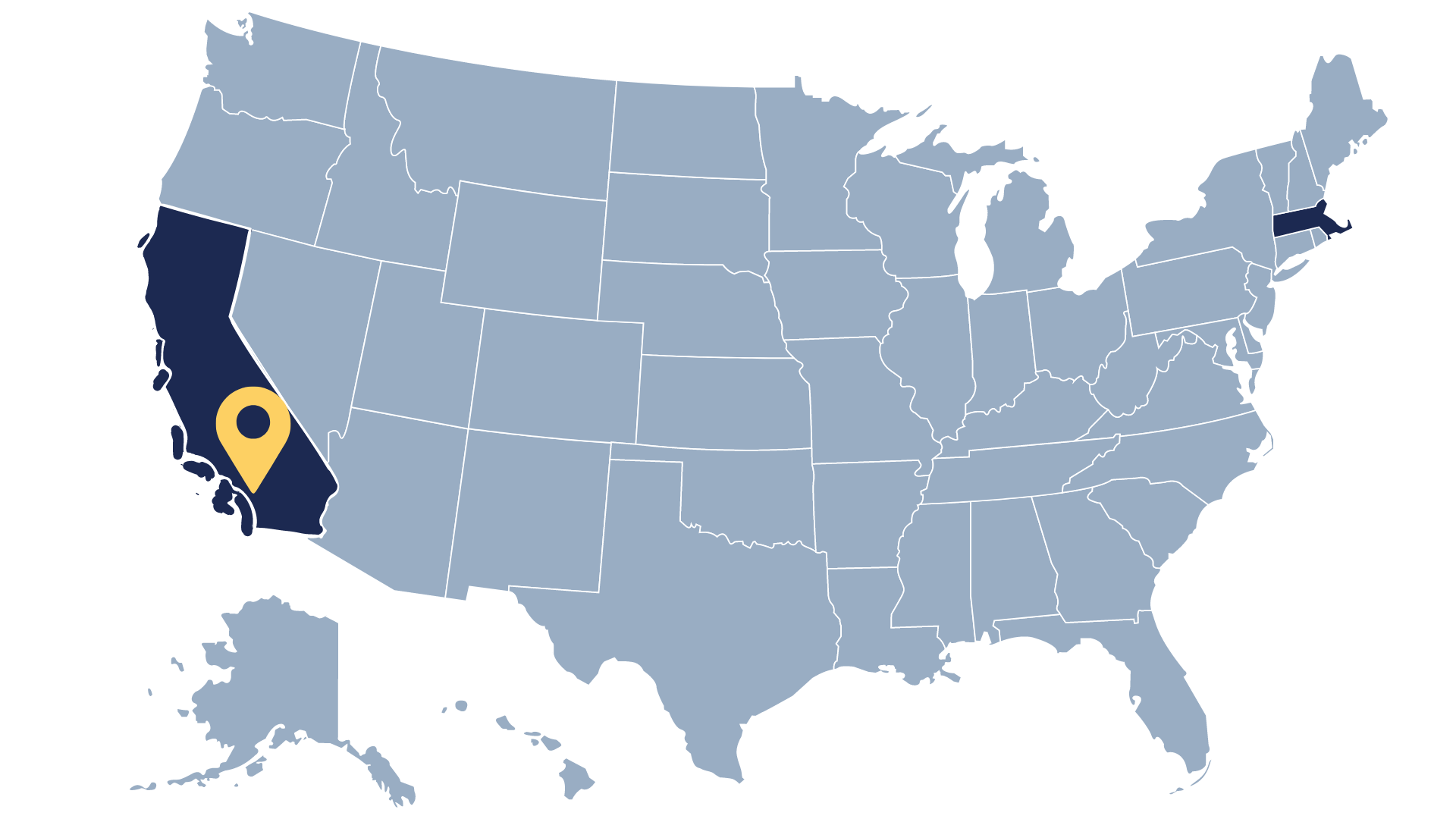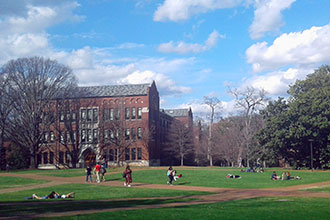REQUIREMENTS AND CAMPUS GUIDE
The California Institute of Technology
The California Institute of Technology, more commonly known as Caltech, is one of the most renowned technical universities in the U.S.—and the world. Founded in the late nineteenth century by Amos Throop, the private institution has developed a reputation of excellence and innovation in science, technology, and engineering, producing groundbreaking research and graduates who boast significant achievements in the field over the last century. If you want to study STEM in college but don’t know if Caltech is the right choice for you, take a look at these frequently asked questions to help you decide!
REQUIREMENTS AND CAMPUS GUIDE
The California
Institute
of Technology
The California Institute of Technology, more commonly known as Caltech, is one of the most renowned technical universities in the U.S.—and the world. Founded in the late nineteenth century by Amos Throop, the private institution has developed a reputation of excellence and innovation in science, technology, and engineering, producing groundbreaking research and graduates who boast significant achievements in the field over the last century. If you want to study STEM in college but don’t know if Caltech is the right choice for you, take a look at these frequently asked questions to help you decide!

REQUIREMENTS AND CAMPUS GUIDE
The California Institute of Technology
The California Institute of Technology, more commonly known as Caltech, is one of the most renowned technical universities in the U.S.—and the world. Founded in the late nineteenth century by Amos Throop, the private institution has developed a reputation of excellence and innovation in science, technology, and engineering, producing groundbreaking research and graduates who boast significant achievements in the field over the last century. If you want to study STEM in college but don’t know if Caltech is the right choice for you, take a look at these frequently asked questions to help you decide!
School Location:
PASADENA, CA
School Type:
PRIVATE RESEARCH INSTITUTE
Admissions Rates:
ADMITTED: 3.9%
GENERAL INFO
SAT/ACT Scores:
Fall 2020 Test Scores
Math: 790-800
ERW:
740-780
ACT: 35-36
Dates/Deadlines:
Early Action: November 1
Early Results: Mid-December
Regular Deadline: January 3
Regular Results: Mid-March
School Information:
Undergraduate Population:
1,023
Faculty Ratio: 3:1
Interview Considered: No
CALTECH TIPS & GUIDE
How difficult is it to get into Caltech?
Caltech is consistently one of the most competitive schools in the nation. In the Fall of 2022 (the most recent year for which Common Data Set information is available), Caltech received 16,626 applications and accepted 448 students, yielding an acceptance rate of 2.7 percent. Caltech seeks to admit students who are passionate about math, chemistry, and physics and appreciate the social sciences and the humanities (subjects in which they are required to complete intensive coursework as freshmen). Students who gain admission to Caltech are described as resilient, creative, collaborative, and determined. Caltech does not publish data concerning average SAT or ACT score or GPA of admitted students, but 96 percent of admitted students in the Class of 2026 were in the top tenth of their high school class.
What is the campus like at Caltech?
Caltech is one of four colleges in Pasadena, California, northeast Los Angeles. Caltech stands out as the only technical university in LA and the city’s most renowned school. Pasadena is best known for hosting the annual Rose Bowl Football game and the Tournament of Roses Parade. Aside from these events, Pasadena tends to be a relatively quiet area but is conveniently located close to the vibrant city of Los Angeles (the second-largest city in the U.S.). To get a better sense of the Caltech community and campus, you can take a virtual tour.
What is Caltech known for?
Caltech is known as a world-renowned science and engineering institute. Caltech faculty and alumni earn recognition on the national and international levels, including 46 Nobel Prizes and 66 National Medal of Science Recipients. The school has an exceptionally low student to faculty ratio of 3:1, with 300 faculty members teaching 1,000 undergraduate students and 1,400 graduate students.
Home to over 50 research centers and institutes, research is the cornerstone of a Caltech education. Caltech treats its students like professional scientists from the moment they step foot on campus. This distinct approach seamlessly integrates research and education. Over half of Caltech students begin conducting research during their first year, and 9 out of 10 undergraduates participate in research while at the school. As such, Caltech offers numerous opportunities for undergraduates to participate in research, including the Summer Undergraduate Research Fellowships (SURF) and various exchange programs, which offer students the opportunity to live in another culture and conduct research in a different academic environment.
How diverse is Caltech?
Caltech reported that their Class of 2027 is composed of 263 students, 59% of which are males and 41% females, with 37% of students being Asian, 5% Black or African American, 11% Hispanic, 22% White, and 17% Nonresident Alien.
How do I apply to Caltech?
Caltech accepts applications in two rounds: Restrictive Early Action and Regular Decision. Restrictive Early Action (REA) is an early admissions process which allows students to learn of their admissions decision by mid-December. Applications are due November 1 (2024 date). Students are not required to accept a Caltech REA offer and may compare financial aid options if they choose to apply to other institutions during the Regular Decision process.
Students who apply to Caltech through the restrictive early action program can not apply to any other schools early action or early decision, with the exception of:
- An institution outside of the United States;
- Any public institution that has a non-binding admissions policy with a fall application deadline (such as the University of California system);
- An institution’s non-binding rolling admissions process;
- If you are deferred admission after applying REA to Caltech, you may apply to another institution’s Early Decision II program. If you are admitted to that institution’s Early Decision II program, you are required to withdraw your application of admission to Caltech.”
Students who apply to Caltech through the restrictive early action program may be admitted, deferred or denied admission.
Students applying to Regular Decision admission must submit their applications by January 3rd (2024 date). Caltech reports that most admitted students applied Regular Decision.
Caltech applicants must submit the following application materials in order to be considered for admission:
- Common App or QuestBridge Application.
- Caltech is a QuestBridge Partner, meaning that low-income students who have been selected as Finalists can apply to Caltech for free through Questbridge’s National College Match program or through Questbridge Regular Decision. Caltech also offers multiple options for students to get fee waivers, including an email from a school counselor.
- $75 application fee or fee waiver.
- School Report
- Standardized Tests Score: SAT or ACT
- Teacher evaluations
- Official transcripts from your secondary school (grades 9-11, or the international curriculum equivalent).
- Transcripts for college classes
- Mid-Year Report
- Note that international students have additional application requirements.
- Applicants can also submit supplemental materials, including but not limited to research papers, abstracts or publications, maker portfolios, visual arts or internship descriptions through the application portal.
- Applicants will write Caltech’s supplemental application essays. There are three required short essay questions that will serve as insight into their qualities as students, scientists, and people. Students can also answer three optional short answer questions about their social life or personal identity and hobbies to give the admissions committee more insight into their personalities.
Am I eligible to apply to Caltech?
Caltech has a few specific requirements for prospective applicants. They require that students have completed four years of English and math (including one year of calc), one year of physics, one year of chemistry, and two years of history and/or social sciences by the time that they graduate. It is also recommended that students complete one year of biology, and though only two years of history or social science are required, 3+ are recommended.
What are Caltech’s core curriculum and programs?
At Caltech, ‘techers’ declare their “option” (Caltech speak for major) at the end of their freshman year. Academics at Caltech are split into six academic divisions as follows: Biology & Biological Engineering, Chemistry & Chemical Engineering, Engineering & Applied Science, Geological and Planetary Science, Humanities and Social Sciences, and Physics, Mathematics & Astronomy.
In addition to a variety of majors and minors like Economics and History, students can choose to pursue an Interdisciplinary Studies Program. This program allows students to design, with a faculty adviser, a customized course of study that is not fully addressed by existing Caltech options.
Does Caltech have a good athletic department?
Caltech has several intercollegiate varsity sports at the Division 3 level. About 25% of Caltech students compete in the NCAA. They also offer several intramural sports, such as basketball, dodgeball, soccer, and volleyball!
Can I afford Caltech?
Like many top schools, Caltech offers generous need-based financial aid. Additionally, their admissions are need-blind for U.S. citizens. Financial aid funds for international students are more limited, so those admissions are need-aware to ensure they can meet admitted students’ full demonstrated need. Without aid, the total cost of attending Caltech and living on-campus for the 2024-2025 academic year is $90,822. This estimate includes tuition, fees, housing, food, as well as estimated personal and living expenses, and books.
Though this college is undoubtedly costly, many will qualify for financial aid, which Caltech offers through grants, scholarships, work-study, and loans.
There are a couple of factors that can affect your financial aid even after you’ve started attending Caltech. In order to maintain your financial aid, you must demonstrate “satisfactory academic progress.” On the other hand, “underloading” (taking fewer classes than a full course load) can decrease your cost of tuition and, consequently, your financial aid package as well. Financial aid can also change with your family circumstances (for example, if one of your siblings begins or finishes college). Students can use the Net Price Calculator for each school they’re seriously considering attending. To find out what Caltech would cost for you and your family, you can estimate your EFC (expected family contribution) and financial aid package, here.
How does Caltech compare to MIT?
If you want to attend a top technical institute in the U.S., you have a few popular options: MIT, Georgia Tech, and Caltech. MIT is one of the most world-renowned universities for STEM, and comes in at the top of most STEM-related rankings. One other notable difference is that MIT is significantly larger than Caltech—in October of 2023—4,576 undergraduate students were enrolled at MIT. During the same academic year, 1,023 undergraduate students were enrolled at Caltech. As Caltech points out, the school is designed to have a small and intimate campus community.
While it might be helpful to compare different aspects of each school, one is not objectively better than the other; they both excel in particular areas, and it’s up to you to decide what are the most important criteria for you. Both schools conduct cutting-edge research and have well-funded labs, meaning that you will flourish as a student and scientist as long as you take the initiative during your time there!
What special opportunities does Caltech have?
Caltech uniquely offers a 3/2 program, which allows students to earn two degrees in five years: one from a liberal arts college and a second from Caltech. Caltech partners with the following schools in offering such a program: Bowdoin College (ME), Bryn Mawr College (PA), Grinnell College (IA, Haverford College (PA), Mt. Holyoke College (MA), Oberlin College (OH), Occidental College (CA), Ohio Wesleyan University (OH), Pomona College (CA), Reed College (OR), Spelman College (GA), Wesleyan University (CT), Whitman College (WA)
Attending Caltech comes with more than just the privilege of studying at one of the most prestigious research institutions in the world; you can also study abroad and make the whole world your classroom. Caltech currently offers six official programs in Cambridge, London, Copenhagen, Edinburgh, Paris, and Melbourne. You can learn more about these programs on the Fellowship Advising and Study Abroad Office website.
If you’re not so keen on the idea of going abroad to study but still want to add some variety to your college experience, then Caltech’s Study Away program might be a good fit for you. Caltech has a formal agreement with The University of Chicago allowing students to spend a semester studying in Chicago and receive Caltech credit.
What is residential life like at Caltech?
Caltech doesn’t have dorms; instead it has eleven student houses and residences, which consist of single, double, and triple bedrooms. Of these eleven, 8 are traditional Houses (or unique residence halls with their own traditions and cultures). Each of these housing options is a small, close-knit residential community staffed by at least one Resident Associate and one Residential Life Coordinator. Caltech guarantees housing for first- and second-year undergraduates, as well as transfers. A vast majority of students live on campus for their entire undergraduate experience, resulting in a strong sense of community (and prank-filled culture). Each of the houses plans social events and outings, often collaborating with other houses. Since housing is important to Caltech, first years are placed in temporary housing until they’ve had time to explore each of their housing options during a two-week period called “Rotation.” During Rotation, students have the freedom (and are encouraged) to move to a different house or residence to find the right fit. Housing costs vary by room and building, so if you want to experience living in a nicer room, you don’t have to commit to paying the higher fee for all four years.
What extracurricular opportunities do they have at Caltech?
Caltech has a variety of clubs that cater to various academic interests, religious communities, sports, and other interests such as mixology and feminism. You can check out the full list of clubs on their website. You also have an opportunity to start your own club at Caltech, so if you don’t see a club that perfectly matches your interests, you can assemble a group of people and found a new organization.




